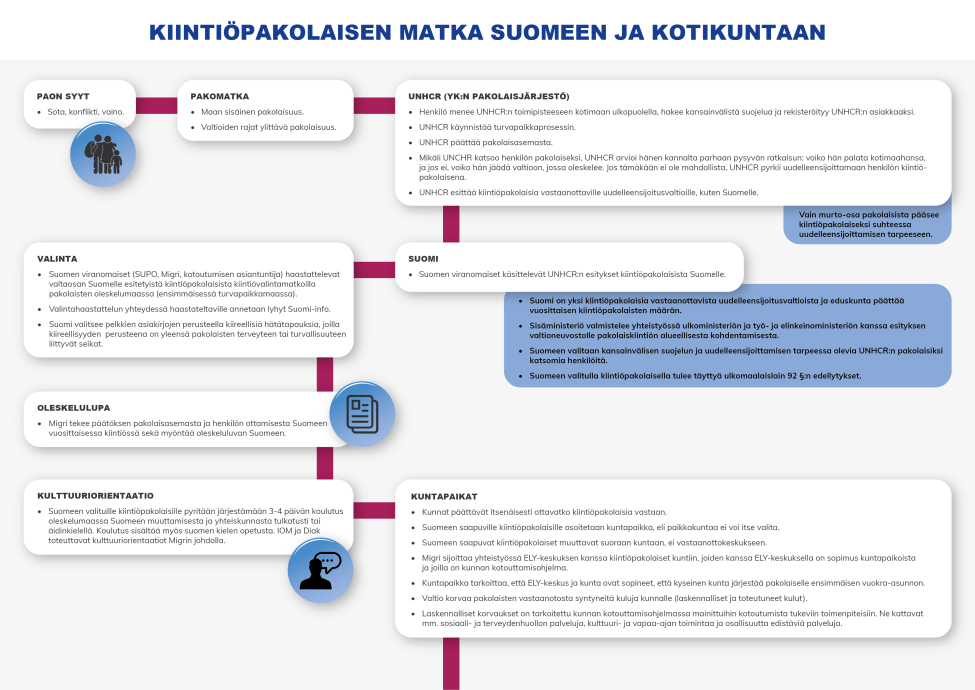-
Who We Are
WHO WE AREThe International Organization for Migration (IOM) is part of the United Nations System as the leading inter-governmental organization promoting since 1951 humane and orderly migration for the benefit of all, with 175 member states and a presence in over 100 countries. IOM has had a presence in Finland since 1993.
About
About
IOM Global
IOM Global
-
Our Work
Our WorkAs the leading inter-governmental organization promoting humane and orderly migration, IOM plays a key role to support the achievement of the 2030 Agenda through different areas of intervention that connect both humanitarian assistance and sustainable development. In Finland, IOM facilitates migrants’ integration, promotes development cooperation, assists victims of trafficking, and engages in refugee resettlement and migrants’ voluntary returns. IOM Finland’s operations cover Finland, Sweden and Iceland.
Cross-cutting (Global)
Cross-cutting (Global)
- Data and Resources
- Take Action
- 2030 Agenda
Quota Refugee’s Journey to Finland and Home Municipality – Infographic Summarizes
Helsinki – Finland is committed to receiving 1,050 quota refugees this year. A revised version of the infographic illustrating quota refugee's journey to Finland and hometown, made by IOM Finland, Finnish Refugee Council and Diaconia University of Applied Sciences, has now been published.
Wars, conflicts and persecution force people to flee their homes. A person can apply for international protection by contacting the United Nations Refugee Agency (UNHCR) outside their home country. UNHCR determines who can no longer return to their home country or stay in the country to which they have fled. In other words, it assesses whether the criteria for resettlement are met in the applicant’s case. Only a small percentage of all the people needing resettlement are being accepted.
Finland decides which nationalities and from which regions it receives quota refugees. The Finnish authorities interview most quota refugees that are presented to Finland on selection trips in the refugees’ country of residence.
The Finnish Immigration Service (Migri) makes the decisions to admit a person to Finland in the annual quota. It also issues a residence permit.
The integration process of quota refugees bound for Finland begins already in the country of departure, as IOM Finland in cooperation with Diaconia University of Applied Sciences organize them a cultural orientation before their travel to Finland. Cultural orientation is a 3–4-day training covering moving to and living in Finland, as well as the basic information about the Finnish society. The participants also learn some Finnish. The aim is to inspire them to familiarize themselves with Finland and the Finnish language. Cultural orientation is organized in the participants’ own language or through an interpreter. The Finnish Immigration Service coordinates the organization of cultural orientations.
The Finnish municipalities decide independently whether they receive quota refugees. The Centre for Economic Development, Transport and the Environment and the Finnish Immigration Service direct the quota refugees to the municipalities. The municipalities need for example an integration programme and suitable rental departments available in order to receive quota refugees. Thus, a person who arrives as a quota refugee does not end up in a reception center.
IOM makes the travel arrangements for quota refugees from their place of departure to their new home municipality in Finland. This may include transport by airplane, train and/or bus.
The Finnish Red Cross assists the quota refugees on their arrival at the airport in Finland and shows them the way to their new home. The quota refugees have a residence permit with full right to work right from the beginning of their new life in Finland.
Quota refugees’ integration process continues with meetings at the basic services where initial counselling and guidance is provided. This means for example registering as Finnish resident, health check-ups, opening a bank account and handling matters with the social security provider. Families with small children apply for a place in day care and older children are registered for school. The basic service providers with whom the newcomers interact therefore play an important role in supporting the integration process. Each meeting between a client/patient and a professional is a possibility to promote integration.
An integration plan is made at the Employment and Economic Development Office for adults belonging to workforce. For adults outside of workforce, such as stay-at-home parents and retirees, an integration plan is made in the municipal services. The integration period is usually three years.
The infographic illustrating quota refugee’s journey to Finland and home municipality is made by Finnish Refugee Council, IOM Finland and Diaconia University of Applied Sciences as part of the Navigator project. The project donor is the European Union Asylum Migration and Integration Fund (AMIF). You can download the infographic in English, Finnish or Swedish on our Publications page.
Facts
Finland has agreed to receive 1050 quota refugees in 2021. The decision has been made by the Finnish Parliament.
Quota refugee means a person
- who has had to flee from their home country or country of permanent residence;
- who cannot stay in the country to which they have fled; and
- whom the United Nations Refugee Agency UNHCR has determined to be a refugee.
In 2020 most of the quota refugees who came to Finland were Syrians or Congolese (the Democratic Republic of Congo).
Finland receives in particular people in situation of vulnerability, such as families with children and women in difficult situation (for example widows, single parents and migrants who are alone).
